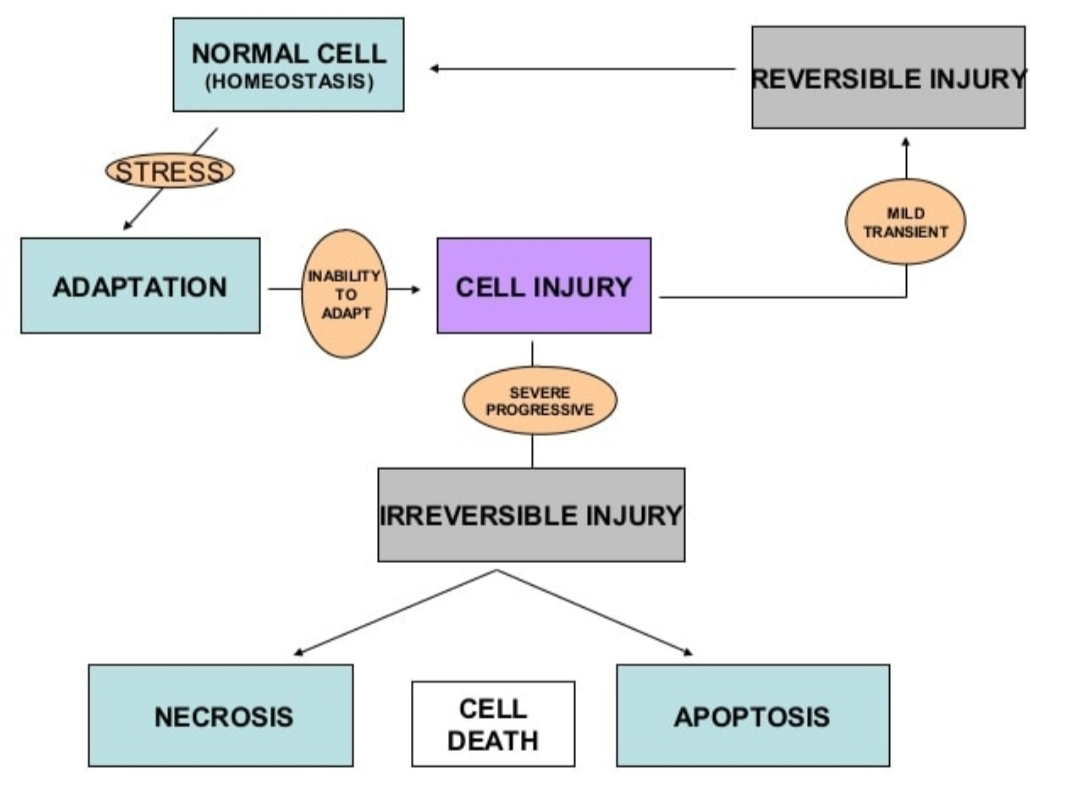Introduction to cell injury and it's Causes.
Definition of cell injury- Cell injury defined as the effect of a variety of stress due to etiological agents a cell encounters resulting in change in its internal and external environmental.
↬ cells actively interact with their environment, constantly adjusting their structure and function to accommodate/ adopt changing demands and extracellular stresses. where as stress means increase work load in heart.
↬ Intracellular substance of the cells is normally tightly regulated such as Homeostasis
↬ As cells encounter physiologic stresses or potentially injurious conditions(such as nutrient deprivation)
↬ when body cell are exposed to antigen then they have inbuilt mechanism to deal with change in environment or adaptation but cellular injury occurs when a stress exceeds the cells can not ability to adopt.
Cellular adaptation- The cells of our body they have the power or capacity to a response to stressful by changing but when stress removed then morphological changes cells comeback to normal size is known as cellular adaptation.
↬When the stress is mild to moderate then injured cell may recover is known as reversible cell injury and when stress is persistent and severe form of cells injury may cause cell death or irreversible cell injury.
↬ Cell death is one of the most crucial events in the evaluation of disease in any tissue or organ.
ETIOLOGY OF CELL INJURY
↬The cells may be broadly injured by two major ways:
A. Genetic causes
B. Acquired causes
↬The acquired causes of disease comprise vast majority of common diseases afflicting mankind. Based on underlying agent, the acquired causes of cell injury can be further categorised as under:
1. Chemical agents and drugs
2. Oxygen deprivation or Hypoxia
3. Microbial agents
4. Ageing
5. Physical agents
6. Nutritional imbalances
7. Immunologic agents
8. Psychogenic diseases
9. Iatrogenic factors
10. Idiopathic diseases.
CHEMICALS AND DRUGS- All the excess amount of the chemical is causes the injury to cell but in normal quantity it beneficial.
All the chemical that cause cell injury.
An ever-increasing list of chemical agents and drugs may cause cell injury. Important
examples include the following:
i) chemical poisons such as cyanide, arsenic, mercury;
ii) strong acids and alkalis;
iii) environmental pollutants;
iv) insecticides and pesticides;
v) oxygen at high concentrations;
vi) hypertonic glucose and salt;
vii) social agents such as alcohol and narcotic drugs; and
viii) therapeutic administration of drugs.
OXYGEN DEPRIVATION/HYPOXIA
Cells of different tissues essentially require oxygen to generate energy and perform metabolic functions.
Deficiency of oxygen or hypoxia results in failure to carry out these activities by the cells.
Hypoxia is the most common cause of cell injury due to reduced blood supply to cells.
Hypoxia classified by four way- these are
Hypoxic hypoxia/ generalized, Anemic hypoxia, Stagnant hypoxia, Histotoxic Hypoxia
a) Hypoxic hypoxia/ generalized hypoxia-
Reduced supply of oxygen in the air/ environment or decreased lung ventilation on respiratory disease.
Partial pressure of oxygen in the arterial blood is lower than normal
For example- high altitude,- where concentration of atmospheric oxygen is decreased.
b) Anemic hypoxia- Low quantity of the Hb blood in the artery and they unable to carry oxygenated Hb blood to the cells for neutrition is known as Hypoxia
For example- corbon monoxide poisoning, where as CO have high affinity to bind with Hb as compare to Oxygen
c) Stagnant hypoxia- In adequate blood supply to tissue
Slow circulation of blood means inadequate oxygen delivered to important cells/ tissue and organs for example- cardiac arrest.
d) Histotoxic Hypoxia- Cells or tissue rejection of oxygenated blood because of cells are damaged and can not extract or absorb oxygen from circulating blood.
It may occurs with the over use of alcohol or drugs and also seen in cyanide poisoning.
MICROBIAL AGENTS Injuries by microbes include infections caused by bacteria, rickettsiae, viruses, fungi, protozoa, metazoa, and other parasites.
AGEING Cellular ageing or senescence leads to impaired ability of the cells to undergo replication and repair, and ultimately lead to cell death culminating in death of the individual.
PHYSICAL AGENTS Physical agents in causation of disease are as under:
i) mechanical trauma (e.g. road accidents);
ii) thermal trauma (e.g. by heat and cold);
iii) electricity;
iv) radiation (e.g. ultraviolet and ionising); and
v) rapid changes in atmospheric pressure.
NUTRITIONAL IMBALANCE A deficiency or an excess of nutrients may result in nutritional imbalances.
Nutritional deficiency diseases may be due to overall deficiency of nutrients (e.g. starvation), of protein calorie (e.g. marasmus, kwashiorkor), of minerals (e.g. anaemia), or of trace elements.
Nutritional excess is a problem of affluent societies resulting in obesity, atherosclerosis, heart disease and hypertension.
IMMUNOLOGIC AGENTS Immunity is a 'double-edged sword'—it protects the host against various injurious agents but it may also turn lethal and cause cell injury e.g.
i) hypersensitivity reactions;
ii) anaphylactic reactions; and
iii) autoimmune diseases.
PSYCHOGENIC DISEASES
There are no specific biochemical or morphologic changes in common acquired mental diseases due to mental stress, strain, anxiety, overwork.
Frustration e.g. depression, schizophrenia.
Problems of drug addiction, alcoholism, and smoking result in various organic diseases such as liver damage, chronic bronchitis, lung cancer, peptic ulcer, hypertension, ischaemic heart disease etc.
IATROGENIC CAUSES Although as per Hippocratic oath, every physician is bound not to do or administer anything that causes harm to the patient, there are some diseases as well as deaths attributed to iatrogenic causes (owing to physician).
Examples include occurrence of disease or death due to error in judgement by the physician and untoward effects of administered therapy (drugs, radiation).
IDIOPATHIC DISEASES Idiopathic means “of unknown cause”. Finally, although so much is known about the etiology of diseases, there still remain many diseases for which exact cause is undetermined. For example, most common form of
hypertension (90%) is idiopathic (or essential) hypertension.
Similarly, exact etiology of many cancers is still incompletely known.


Comments
Post a Comment